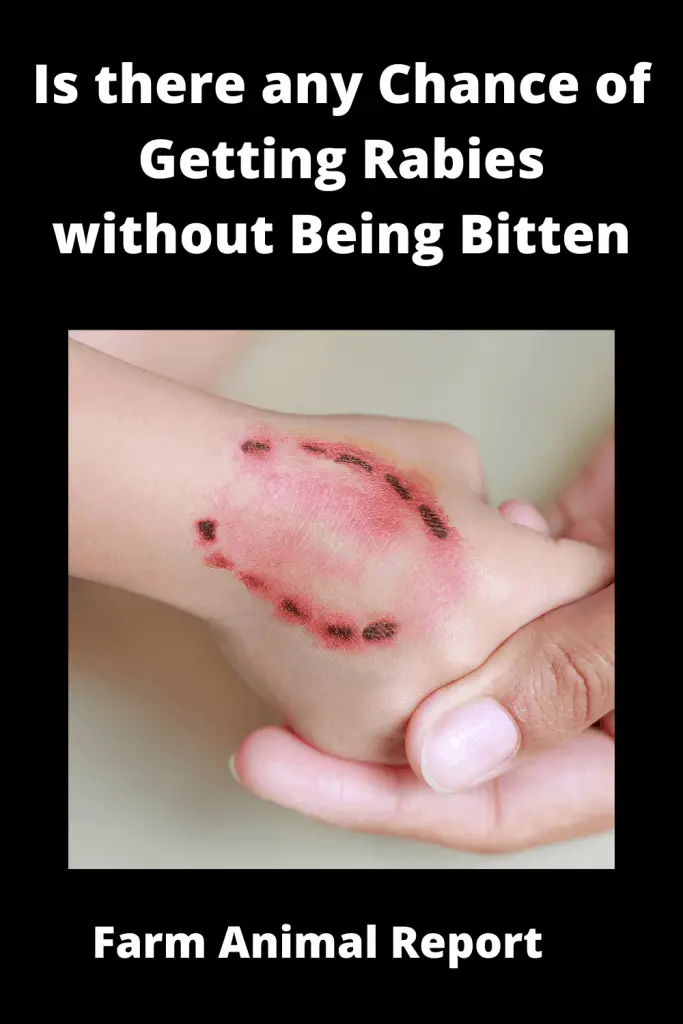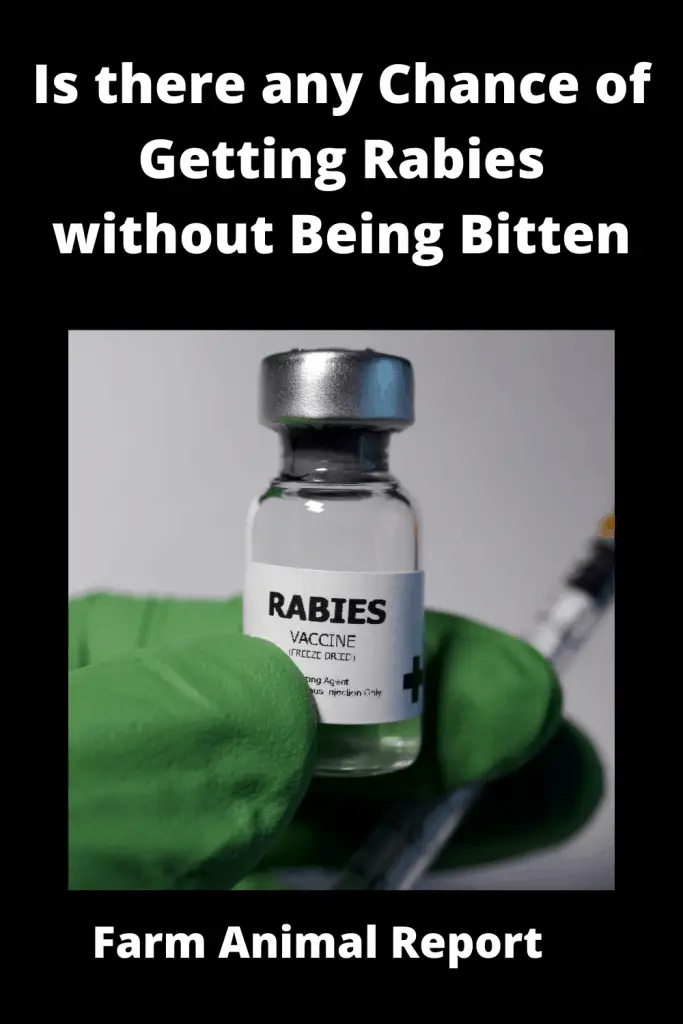As a General Rule Though it is possible for someone to contract rabies from non-bite exposures, such as scratches or open wounds that come into contact with animal saliva and other potentially infectious materials
A person can also get infected through a bite. However, this occurs very rarely because only mammals have the virus in their systems which makes them eligible candidates for infection
Chances of Getting Rabies without Being Bitten
Is there any Chance of Getting Rabies without Being Bitten – People can get Rabies without being bitten, but it is rare, for people or animals to get rabies without being bitten, which can include scratches, abrasions, or open wounds exposed to saliva or other potentially infectious material from a rabid animal? Here, we will discuss the transmission of rabies, which animals can carry the disease, the pathway of rabies, and the signs and symptoms of rabies-affected animals. Chances of Getting Rabies without Being Bitten
See Amazons Educational Resources on Rabies
Mode of Transmission of Rabies Virus:
- The transmission being bitten:
- Rabies virus is transmitted through broken skin or mucous membrane in the eyes, nose, or mouth with saliva or brain/nervous system tissue from an infected animal.
- Without being bitten transmission:

- People and animals can get rabies from non-bite exposures, which can include scratches, abrasions, or open wounds exposed to saliva or other potentially infectious material from a rabid animal.
- Inhalation of an aerosol of rabies virus.
- Rabies transmission through corneal and solid organ transplants have been recorded, but they are also infrequent.
- Rabies cannot transmit:
- Petting a rabid animal or contact with the blood, urine, or feces of a rabid animal, are not associated with risk for infection and is not considered to be exposures of concern for rabies.
- Casual contact, such as touching a person or animals with rabies or contact with non-infectious fluid or tissue, is not associated with risk for infection.
- Contact with animals or people receiving rabies exposure does not pose a risk for disease and does not require postexposure prophylaxis.
Rabies virus becomes noninfectious when it dries out and when it is exposed to sunlight. Different environmental conditions affect the rate at which the virus becomes inactive, but in general, if the material containing the virus is dry, the virus can be considered non-infectious.
Which Animal Carry Rabies?
- All mammals can get rabies, but only a few species are important as reservoirs for the disease. In the United States, distinct strains of rabies virus have been identified in bats, raccoons, skunks, foxes, and mongooses.
- In many other parts of the world, rabies in dogs is still prevalent.
What is the Pathway of the Virus in the Body?
Different studies conducted on rabid dogs, cats, and ferrets have come to know that the rabies virus is introduced into a muscle through a bite from another affected animal. It travels from the site of the bite to the brain by moving within nerves. The animal does not appear ill during this time.
There is the Following Path of the Rabies Virus:
- A rabid animal bites an animal.
- Rabies virus from the infected saliva enters the wound.
- Rabies virus travels through the nerves to the spinal cord and brain. This process can last approximately 3 to 12 weeks. The animal has no signs of illness during this time.
- When it reaches the brain, the virus multiplies rapidly and passes to the salivary glands. The animal begins to show signs of the disease.
- The infected animal usually dies within seven days of becoming sick.

Signs and Symptoms of Rabid Animal or Person:
- The first symptoms of rabies may be very similar to those of the flu, including general weakness or discomfort, fever, or headache. These symptoms may last for days.
- There may also be discomfort or a prickling or itching sensation at the bite’s site, progressing within days to acute symptoms of cerebral dysfunction, anxiety, confusion, and agitation.
- As the disease progresses, the person or animal may experience delirium, abnormal behavior, hallucinations, hydrophobia (fear of water), and insomnia.
- The acute period of disease typically ends after 2 to 10 days.
How Can You Diagnose your Animal or Person is Suffered from Rabies?
Direct Fluorescent Antibody (DFA) Test:
In animals, rabies is diagnosed using the direct fluorescent antibody (DFA) test, which looks for rabies virus antigens in brain tissue. In humans, several tests are required.
Rapid and Accurate Laboratory Diagnosis:
Rapid and accurate laboratory diagnosis of rabies in humans and other animals is essential for timely animals and is necessary for the appropriate administration of post-exposure prophylaxis. Within a few hours, a diagnostic laboratory can determine whether an animal is rabid and informs the responsible medical personnel. The laboratory results may save a patient from unnecessary physical and psychological trauma, and financial burdens, if the animal is not rabid.
Besides, laboratory identification of positive rabies cases may help define current epidemiologic patterns of disease and provide appropriate information for the development of rabies control programs.
The nature of rabies disease dictates that laboratory tests be standardized, rapid, sensitive, specific, economical, and reliable.

How Can You Prevent your Animals from Rabies?
There are Several Things You Can do to Protect Your Pet from Rabies.
First, visit your veterinarian with your pet regularly and keep rabies vaccinations up-to-date for all cats, ferrets, and dogs. Puppies and kittens should receive their first rabies vaccination at 12 weeks of age. Pets must be vaccinated again in one year, and then a three-year rabies vaccine is generally administered during the rest of your pet’s life. Many animal control agencies and humane societies offer free or low-cost vaccinations. To find inexpensive options in your area, call your local animal shelter.
- Second, maintain control of your pets by keeping cats and ferrets indoors and keeping dogs under direct supervision.
- If your pet bites a person or another animal, consult your veterinarian immediately. Most states require that bites to humans be reported to the local health department. An animal control officers may contact you to file this report, and you will be required to show proof of your pet’s rabies vaccination.
- If another known domestic animal bites your pet, consult your veterinarian immediately and ask the owner to provide proof of rabies vaccination. If the other animal is not up-to-date on his vaccine, it is advisable to report the incident to your local animal control authority to ensure that it is quarantine approximately.
- If your pet receives a suspected bite wound from an unknown animal or if your pet comes in direct contact with any wild animal, even if no injuries are evident, consult your veterinarian immediately. Your veterinarian may recommend a rabies booster.
Third, spay or neuter your pets to reduce the number of unwanted pets that may not be adequately cared for or vaccinated regularly.
Finally, call animal control to remove all stray animals from your neighborhood since these animals may be unvaccinated or ill.
The Importance of Vaccinating Your Pet:
- While wildlife is much more likely to be rabid than are domestic animals in the United States, people have much more contact with local animals than with wildlife.
- Your pets and other domestic animals can be infected when rabid wild animals bite them, and this type of spillover increases the risk to people.
- Keeping your pets up-to-date on their rabies vaccination will prevent them from acquiring the disease from wildlife, and thereby avoid possible transmission to your family or other people.
Reducing Your Risk of Getting Rabies from Wildlife:
- Don’t keep wild animals as pets. Americans keep more than 4.7 million exotic animals as pets, which cannot be vaccinated against rabies.
- Avoid direct contact with wildlife, dead or alive. Never touch any wildlife with your bare hands. If you find a sick or injured wild animal, call your local animal control agency or humane society and let the experts handle it.
Avoid Animals Displaying Unnatural Behavior.
- Wild animals that are unusually friendly or displaying other unnatural behaviors may have the rabies virus.
- Discourage contact between pets and wildlife. Don’t let your pets roam or encourage them to interact with unfamiliar domestic or wild animals.
- Feed your pets indoors. Leaving food outside often attracts stray dogs, cats, and wildlife to your yard.
- Animal-proof your trash. Make sure your trash lids are locked and don’t leave bags of garbage outside the cans.
- Prevent wild animals from getting into the house. Prune tree branches that overhang the roof. Keep screens on windows and cover small openings, such as chimneys, furnace ducts, and eaves.
- Report all stray animals to animal control. Stray animals may not be vaccinated for rabies. They also run a high risk of exposure to wild animals who carry the disease.
- Give your child some guidelines to follow. Do not frighten your children, but make sure they learn some basic rules about protecting themselves from strange or unfamiliar animals.

What Are the Preventive Measures You will Adopt for the Prevention of Rabies?
- The prevention of human rabies depends on the active and correct control of the disease within the domestic dog population, being the most common reservoir of the virus and causing 99% of human cases.
- WHO promotes wider access to appropriate post-exposure treatment using the cost-effective multi-site intra-dermal regimen with modern tissue culture or avian embryo-derived rabies vaccine.
- Possible domestic production of rabies biological, particularly rabies immunoglobulin, which are in critically short supply globally.
- Continual education of health and veterinary professionals in rabies prevention and control public health educational strategies at the community level within endemic regions.
Can you get Rabies from a Scratch?
– Rabies is spread through saliva and usually enters the body via an open wound or sometimes just breaks in skin that occurs during fighting between animals. It can also be transmitted to humans by contact with infected tissue of dead animals. There are only a handful of documented cases where rabies was transmitted through a scratch.
– However, in order to avoid contracting diseases it is very important that you practice safe handling of your animals and always wear gloves when cleaning out cages or feeding them.
What Are Rabies Laws?
- Most states have laws mandating rabies vaccinations for both dogs and cats.
- Most states also have laws requiring rabies quarantine for animals that have bitten a person or another animal.
- Some states also have mandatory rabies quarantine for unvaccinated pets who have been bitten by a wild animal or have a suspected bite wound of unknown origin.
Why a Ten-Day Quarantine?
- In almost all states, an animal that has bitten a human or another domestic
The animal must undergo a mandatory 10-day quarantine period. Some states require that this quarantine be carried out in an approved animal control facility, while others may allow the quarantine to be carried out at the owner’s home.
- The quarantine is set at 1o days because a rabies-infected animal can only transmit the disease after clinical signs have developed, and once these signs have emerged, the animal will die within ten days.
- If the animal lives beyond the 10th day, it can be said with certainty that it was not shedding the rabies virus at the time that the bite occurred.
- If the animal dies before the 10th day, it can be tested for rabies. If the test is positive, a human bite victim will still have enough time to receive post-exposure vaccination and prevent it.
Why a Six-Month Quarantine?
- In many states, an unvaccinated domestic animal that has been bitten by a wild animal or has received a suspected bite wound of unknown origin must undergo a six-month rabies quarantine. Most often, state law requires that this quarantine be carried out in an approved animal control facility at the owner’s expense. Because the incubation period for rabies is usually less than six months, this quarantine period is meant to ensure that the animal does not have rabies before it is allowed to come into regular contact with humans and the other animals again.
- If an owner is unable to comply with this law or cannot afford to pay for the mandatory six-month quarantine, the only alternative for the pet is compulsory euthanasia and testing for rabies.
- Keeping your pet’s rabies vaccination up to date will ensure that he never needs to be quarantined for six months, even if a wild animal bites him.


